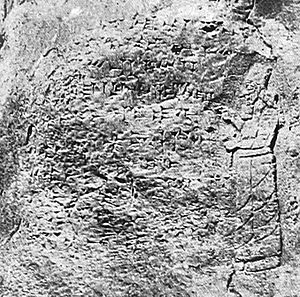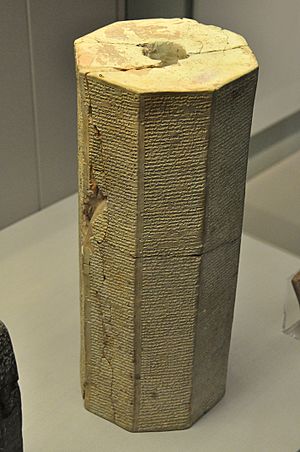Tiglath-Pileser I facts for kids
Quick facts for kids Tiglath-Pileser I |
|
|---|---|
|
|

Rock relief of Tiglath-Pileser I
|
|
| King of the Middle Assyrian Empire | |
| Reign | 1114–1076 BC |
| Predecessor | Ashur-resh-ishi I |
| Successor | Asharid-apal-Ekur |
| Died | 1076 BC |
| Issue | Asharid-apal-Ekur, Ashur-bel-kala, Shamshi-Adad IV |
| Akkadian | 𒆪𒋾𒀀𒂍𒈗𒊏 TUKUL.TI.A.É.ŠÁR.RA Tukultī-apil-Ešarra |
| Religion | Ancient Mesopotamian religion |
Tiglath-Pileser I was a powerful king of Assyria. He ruled during the Middle Assyrian period, from 1114 to 1076 BC. His name, Tukultī-apil-Ešarra, means "my trust is in the son of Ešarra."
Many historians see Tiglath-Pileser as one of Assyria's greatest rulers. He was famous for his many military trips and his love for building projects. He also collected cuneiform tablets, which were ancient writings.
Under his rule, Assyria became the strongest power in the Ancient Near East. This strong position lasted for about 500 years. He expanded Assyrian control into areas like Anatolia and Syria. His empire even reached the shores of the Mediterranean Sea.
Texts from his time show that he wanted his people and his enemies to respect his power. His reign began with many military actions. These actions were often recorded to explain why wars were fought.
Tiglath-Pileser I's rule encouraged the recording of history. His military campaigns were carefully written down. Later in his reign, "summary texts" were created. These texts contained as much information as possible. They were meant to be passed down to future kings.
Tiglath-Pileser I's Military Campaigns
Tiglath-Pileser I became king in 1115 BC. He was the son of Ashur-resh-ishi I. He quickly became one of Assyria's most successful conquerors. He called himself the "unrivalled king of the universe." He also claimed to be "king of the four quarters," meaning the whole world.
He was the first Assyrian king to take control of people from conquered lands. This was a way to show his power over them.
His first major campaign was in 1112 BC against the Mushku people. They had taken over some Assyrian areas near the Upper Euphrates River. After that, he conquered Commagene and eastern Cappadocia. He also pushed the Hittites out of the Assyrian area of Subartu.
In another campaign, Assyrian forces went into the mountains south of Lake Van. Then they moved west to take control of Malatia. In his fifth year as king, Tiglath-Pileser attacked Comana in Cappadocia. He had records of his victories carved on copper plates. These were placed in a fortress he built to protect his new lands in Cilicia.
The Arameans were a group of people who became a threat to the Middle Assyrian Empire. Tiglath-Pileser I led many campaigns into Aramean lands. However, these campaigns did not fully stop the Arameans. Some historians think the Arameans even took over Nineveh for a time.
In the 11th century BC, Assyria faced a period of decline. This might have been due to the Arameans expanding their territory. They set up many states across the Levant. They also took over parts of Assyrian land, like the Khabur Valley. For a while, Assyria could not expand east of the Euphrates River.
Tiglath-Pileser I secured the main road to the Mediterranean Sea. He took control of the Hittite town of Pitru. From there, he traveled to Gubal (Byblos), Sidon, and finally Arvad. At Arvad, he sailed on the Mediterranean Sea. He even hunted a "sea-horse" (which might have been a narwhal) there.
He loved hunting and was also a great builder. He is known for rebuilding the temple of the gods Ashur and Hadad in the Assyrian capital, Assur. He was also one of the first Assyrian kings to create parks and gardens. These gardens featured trees and plants brought from other countries.
Towards the end of his rule, Tiglath-Pileser I faced more pressure from Aramaean tribes. He died in 1076 BC. His son, Asharid-apal-Ekur, became king after him. His other sons, Ashur-bel-kala and Shamshi-Adad IV, also became kings later.
Records of His Reign
Tiglath-Pileser I's records from his "fifth year annals" were written in different ways. Some were on eight-sided prisms, and others were on cuneiform tablets. These records clearly describe his military campaigns. Each section often started with "in my succession year."
Since much of his reign involved wars, it's not surprising that his writings contain military details. For example, one text says: "Altogether I conquered 42 lands and their rulers... from my accession year to my fifth regnal year." His prism is like a year-by-year diary of his military trips. It is one of the world's best-preserved ancient records.
Triumphs and Tributes
Tiglath-Pileser I's records also describe what he brought back from his successful military campaigns. These items were like early forms of tribute. After returning from a war, he would have statues made of animals he had seen or hunted.
For example, the texts mention that he had:
- Two sculptures of "sea-horses" (nāhirū).
- Four burhiš sculptures.
- Four lions made of basalt stone.
- Two large bull statues made of alabaster.
- Two burhiš sculptures made of white limestone.
These statues were placed at the gates of the City of Ashur. They were used to decorate the "royal entrance." His son, Aššur-bel-kala, continued this practice after his father's death. Besides statues, Tiglath-Pileser I also brought back living animals. These included wild bull calves and even elephants.
See also
 In Spanish: Tiglatpileser I para niños
In Spanish: Tiglatpileser I para niños


